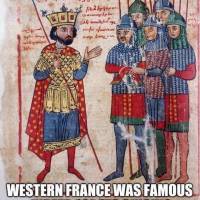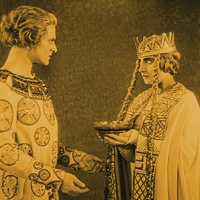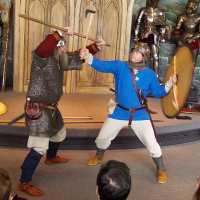Sequitur pars secunda.
Last time, we left the Roman Emperor’s daughter Constance in the safe hands of the constable and his wife Hermengyld in Northumberland. The Man of Law made a point to tell us that Constance is speaking a “Latyn corrupt” to communicate with the constable. Now, if Marie de France were telling this story during the 12th century, she probably would’ve used romance convention to deal with the issue of language barriers. Her Breton lay Guigemar is the story of a knight who is sent on a quest to discover love.

Scenes of Courtly love on ivory mirror case (late 14th century) Musée du Louvre (Photo: Wikipedia)
Guigemar is the son of a baron. His father sends him as young boy to live in a nearby king’s court. There, Guigemar learns the ways of chivalry and when he comes of age the king dubs him a noble and presents him with arms. Guigemar goes to Flanders and fights in many battles. He soon becomes a very famous knight and his name comes to be known throughout all of France. There is, however, one peculiar thing about Guigemar: he has no romantic interest in women. Guigemar returns to Brittany and visits his parents. They are pleased to see that their son has such great success in his professional life. After hanging around his family’s castle for about a month, he feels the urge to go hunting so he summons his knights, hunters, dogs, and beaters and leaves early the next morning to chase game in the forest. When they spot the first stag, his men unleash the dogs and rapidly they run ahead in pursuit of the beast. Guigemar, meanwhile, stays behind with his squire. Soon after the sounds of the dogs fade into the distance, Guigemar and his squire notice in a thicket a white hind with antlers like a buck.

Detail from The Wilton Diptych (c.1395-1399) National Gallery, London (Photo: Wikipedia)
The squire quickly hands Guigemar his bow and arrows. Guigemar shoots the deer in the head only to have his arrow rebound, hitting his own thigh. Guigemar falls off his horse onto a thick patch of grass in such a way that he is face to face with the dying animal. The deer speaks to Guigemar telling him his destiny:
| Ja mais n’aies tu medecine!Ne par herbe ne par racine,Ne par mire ne par poisunN’avras tu ja mes guarisunDe la plaie qu’as en la quisse,
De si que cele te guarisse, Ki suferra pur tue amur Si grant peine e si grant dolur, Qu’unkes femme tant ne sufri; E tu referas tant pur li, Dunt tuit cil s’esmerveillerunt, Ki aiment e améavrunt U ki puis amerunt après. Va t’en de ci! Lai m’aveir pes! (v.109-122)[1] |
Puisses-tu ne jamais trouver de remède!Nulle herbe, nulle racine,Nul médecin, nulle potionNe guériront jamaisLa plaie de ta cuisse
Tant qu’une femme ne viendra par la guérir, Une femme qui souffrira pour l’amour de toi Plus de peines et de douleurs Que nulle autre amoureuse. Et toi, tu souffrirais tout autant pour elle. Et votre amour émerveillera Tous ceux qui aiment, qui ont aimé Et qui aimeront Maintenant va-t’en, laisse-moi en paix! (v.109-122)[2] |
May you never find a cure,nor may any herb,root,or doctor or potionever heal the woundyou have in your thigh
until you are cured by a woman who will suffer likewise for her, so much so that all those who are in love, who have known love or are yet to experience it, will marvel at it. Be gone from here and leave me in peace. (44)[3] |

White hind’s speech to Guigemar from a manuscript (c.1201-1300) Bibliothèque national de France (Photo: gallica) (Quoted text above begins on the 4th line of this detail)
So begins Guigemar’s quest. He bades his squire go find the others and bring help. Now alone, Guigemar soon finds a magical and mysterious boat that is superbly constructed and lavishly decorated. Inside this boat there is a bed quilted with silk woven with gold. Guigemar rests on the bed, waking later to discover that this magical boat has unfurled its silk sail and is taking him on a voyage. He prays to God just as Constance does and is safely brought to port. He lands “below an ancient city, capital of its realm” (46) (desuz une antive cité / esteit chiés de cel regné Au pied d’une vielle cite) (v.206-07). There, Guigemar meets a noble woman who is made by her jealous husband to live in a tall marble structure. The only human contact she has besides her husband is a maiden servant and a eunuch. This structure has only two entrances: a guarded door and a garden which connects to the sea. The woman and her maiden notice the mysterious ship during one of their strolls in the garden and inside they found Guigemar sleeping. As you probably guessed, Guigemar and the lady discover that they are star-crossed lovers. A confrontation with the jealous husband occurs, they are tragically separated but reunited involving the magic boat, a knot, and a chastity belt, their romance is once again threatened by another jealous lord, Guigemar fights in a tournament, razes a castle, and the two lovers ride off into the sunset together. I can’t give you a proper telling but in Marie’s lays you can find the story of Guigemar. Her telling is much fresher in mind than mine.
Marie’s story starts and ends in Brittany during the reign of Hoël so it is in the realm of Arthurian Legend. She has her knight travel to Flanders before the episode with the deer and the story’s events return to Brittany, but the place the magical boat takes Guigemar is not in Brittany. This strange, ancient land is not properly identified. Which language does Guigemar use to communicate with the noble woman and which language does she use to communicate with everyone in Brittany when the magical boat takes her there later in the story? These are details that Marie doesn’t bother herself with in this or any of her lays. You’ll be much more likely to find details of how lavish a magical boat looks than which languages characters from foreign lands are using to converse with each other in Marie’s lays. Marie relies on romance convention to do the translating for her characters. There are so many magical elements in this story already with a talking deer and an unattended magical boat that transports our protagonists to and from Brittany and some unidentified place and time that the audience is in such suspension of disbelief that they don’t question things like which language the characters are using to speak with each other or how is it a knight can talk with a deer!
Chaucer is no stranger to using romance convention to solve language barrier issues between man and bird. Chaucer’s Squire uses it in his tale with the king’s daughter Canace’s magic decoder ring:
| That on hir finger baar the queynte ryngThurgh which she understood wel every thvngThat any fowel may in his leden synAnd koude answeren hym in his ledene ageyn(II 433-36) | That on her finger bore the curious ringBy which she understood whatever thingBirds in their language said, and which could teachHer how to answer in natural speech (400 |
Next time I’ll get back to Constance and the Man of Law’s Tale – I promise!
Explicit sequitur pars.
[1] References to Marie de France in Old French are taken from Lais de Marie de France, Ed. Karl Warnke (Paris, 1990).
[2] References to Marie de France in Modern French translation are taken from Lais de Marie de France, trans. Laurence Harf-Lancner (Paris, 1990).
[3] References to Marie de France in Modern English translation are taken from The Lais of Marie de France, trans. Glyn S. Burgess and Keith Busby (London, 1999).











